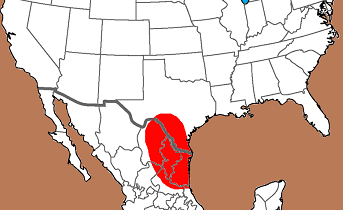Outline is Representative of Size and Shape:

Name Details:
Identified By: Leslie Zubieta Calvert
Named For: Jora Complex
Date Identified: 1999
Type Site: Cueva Encantada, Coahuila, Mexico
Identified By: Leslie Zubieta Calvert
Named For: Jora Complex
Date Identified: 1999
Type Site: Cueva Encantada, Coahuila, Mexico
Point Validity:
Provisional Type
Zubieta Calvert is an anthropologist and professor at the University of Western Australia who specializes in rockart. She joined the University of Texas - Austin in conducting surveys and research of the borderlands of Texas. This type was named in a professional publication. The definition between this type and the Arenosa type needs to be further defined in order to classify this as a distinctive type. The Coahuila is a Collectors type.
Zubieta Calvert is an anthropologist and professor at the University of Western Australia who specializes in rockart. She joined the University of Texas - Austin in conducting surveys and research of the borderlands of Texas. This type was named in a professional publication. The definition between this type and the Arenosa type needs to be further defined in order to classify this as a distinctive type. The Coahuila is a Collectors type.
Jora Contracting Stem
Provisional TypeAKA: Coahuila - (Collectors type)
Cluster:
Description of Physical Characteristics and Flaking Pattern:
This is a thin medium triangular contracting stem point with a flattened to elliptical cross section. The blade is primarily straight, but may range from slightly excurvate to slightly incurvate. The shoulders may range from slightly horizontal to weak and having an upward angle. The stem is contracting with a convex to pointed base. This point is usually well made point with a random flaking pattern.
Size Measurements:
Total Length - 60 to 85 mm, Stem Length - 18 to 30 mm (typically 1/3 to 1/2 total length of point), Blade Width - 18 to 28 mm, Stem Width at shoulders - 13 to 20 mm (*** based on small sample size***)
Total Length - 60 to 85 mm, Stem Length - 18 to 30 mm (typically 1/3 to 1/2 total length of point), Blade Width - 18 to 28 mm, Stem Width at shoulders - 13 to 20 mm (*** based on small sample size***)
Commonly Utilized Material:
Additional Comments:
This is a variant of the Langtry type. The Langtry type generally has a straight to concave base and barbed shoulders. The Langtry Arenosa variant has a longer rounded stem and barbed shoulder. This variant has a long rounded stem and weak shoulders that are horizontal to having an upward angle. The characteristics of the Arenosa and Jora type overlap and both are poorly defined. The difference between the two types may be a result of reduced shoulders due to re-sharpening. However, many publications refer to this type as the Arenosa / Jora type (Bement, 1999).
The name Coahuila seems to be based on Jora points that are associated with the Coahuila Complex. The name Coahuila is more commonly used by collector for Jora points.
This is a variant of the Langtry type. The Langtry type generally has a straight to concave base and barbed shoulders. The Langtry Arenosa variant has a longer rounded stem and barbed shoulder. This variant has a long rounded stem and weak shoulders that are horizontal to having an upward angle. The characteristics of the Arenosa and Jora type overlap and both are poorly defined. The difference between the two types may be a result of reduced shoulders due to re-sharpening. However, many publications refer to this type as the Arenosa / Jora type (Bement, 1999).
The name Coahuila seems to be based on Jora points that are associated with the Coahuila Complex. The name Coahuila is more commonly used by collector for Jora points.
Distribution:

Distribution Comments:
This point is primarily found in northern Mexico and in the lower Pecos region of Texas. This point is found with decreased frequency into southern and south-central Texas.
This point is primarily found in northern Mexico and in the lower Pecos region of Texas. This point is found with decreased frequency into southern and south-central Texas.
Age / Periods:
Date: 5,800 - 5,300 B.P.
Cultural Period: Middle Archaic
Glacial Period: Middle Holocene
Culture:
Date: 5,800 - 5,300 B.P.
Cultural Period: Middle Archaic
Glacial Period: Middle Holocene
Culture:
Age Details:
These points are associated with the early to middle Coahuila Complex. Radiocarbon dating from Frightful Cave for Frightful Cave Coahuila Complex Middle 6,170 +/- 300 B.P.
These points are associated with the early to middle Coahuila Complex. Radiocarbon dating from Frightful Cave for Frightful Cave Coahuila Complex Middle 6,170 +/- 300 B.P.

